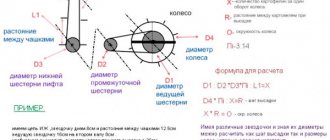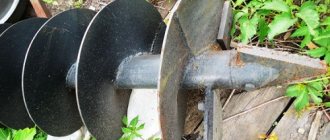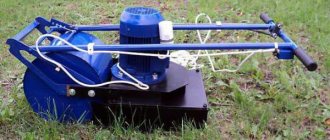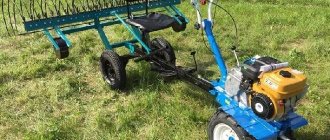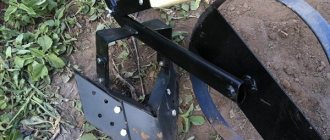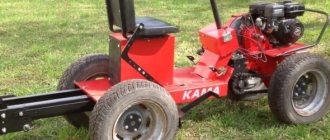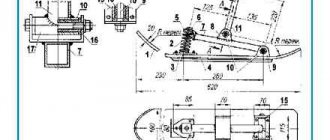There are various models of milling and grain crushing equipment on the market. However, not every farmer can afford this, and suitable models are not always easy to buy and deliver. For this reason, there remains a tendency to independently make the necessary equipment with your own hands from scrap materials. A do-it-yourself mill or grain grinder can be made easily and at minimal cost. Especially relevant for beginning entrepreneurs and small farms.
Description
What is a kruporushka
The device is used for quick preparation of feed from crushed grain. Otherwise they are called grain crushers. On an industrial scale, grain crushers are used in poultry farms and food processing plants.
The following products are most often processed using this method:
- wheat;
- peas;
- millet;
- barley;
- oats;
- buckwheat;
- rice;
- corn;
- peas;
- soybeans
The main difference between a grain grinder and a mill: the grains are not ground into flour, but are simply crushed into several relatively large parts.
Where and how to use
Using the grinder is very simple. At the top there is a bunker where raw materials are loaded. Grinding is carried out in a drum, which is driven by an electric motor. In the drum, the grain is also mixed with other additives - grass, dried vegetables, straw.
Most often, on private farms, grains are used to prepare feed for birds, pigs and cattle. Many types of cereals are processed in agricultural production in a similar way.
Principle of operation
The grains are sent to the receiving hopper, after which they arrive in portions, having gone through the calibration stage. After the preliminary stage of dehusking, the grain enters a drum, in which it is divided into four unequal parts. The different sizes of particles determine the cyclical nature of the work: first, larger pieces are crushed, then small ones go to even smaller ones, until the finished product acquires the same size and beautiful appearance.
The incoming product can be automatically sorted by simply placing a sieve at the outlet. As a result, smaller fractions will be used as poultry feed, while larger fractions will be used for cattle. The productivity of the grinder depends on the hardness and other characteristics of the raw material and ranges from 150 to 300 kilograms per hour. You can additionally equip the device with a grinding device, and then you can eat high-quality grain yourself.
Description of the grain crusher
It is important not to confuse a grain grinder with a mill. The latter grinds the grain into powder - flour, and the grain grinder only grinds it. This allows you to obtain a finer grain fraction. Kruporushki, as the name implies, are used for the production of cereals: rice, barley, buckwheat, millet, peas, corn, etc.
Structurally, the grinder is a rather complex technical device, consisting of several working elements. Operates by electric or manual drive. An important part of this equipment is a sieve - it allows you to sort the final product into fractions. The design may also include devices for cleaning grain, air and fans.
Kruporushki crush grains to make feed
Kinds
Centrifugal
The operating principle and design are broadly reminiscent of an electric coffee grinder. The walls of the tank are equipped with knives that crush the grains raised under the action of centrifugal force.
You can regulate the size of the resulting feed by installing a sieve or grating with meshes of different sizes. Performance depends on the sharpness of the knives and the power of the electric motor.
Screw
Otherwise it is also called auger. The device simultaneously cuts and lightly presses the grain. This is due to the presence of a metal polyhedron and slotted pads inside the device.
The disadvantage of the design is the blunting of the edges of the polyhedron, which affects the productivity, size and quality of the finished grain parts. If you additionally equip the unit with knives, you can double the productivity compared to a conventional auger grinder.
Melnichnaya
The most common and easiest to make grain crusher. They resemble a mill invented by our distant ancestors. Wear-resistant stone millstones are used that do not require sharpening.
A small drawback is the inability to regulate the grinding coarseness and particle size of the final product.
Rolling
It resembles a screw design, but is equipped with a polyhedron with a different number of teeth. Advantages of a rolling grinder: easy and simple adjustment of the quality of grain grinding. When using a round grater, you can completely set the dimensions of the finished product down to tenths of a millimeter.
Product types
The first grain grinders or grain crushers were millstones on which grain was ground manually or with the help of horse traction. Over time, this design was improved and today you can find different types of grain crushers.
Centrifugal
Centrifugal or impact crusher is based on the impact crushing method. The design resembles a centrifuge. The grain enters a rotating plane, is accelerated by centrifugal force and is thrown into a crushing chamber with a special hard lining. The high kinetic energy of particles ensures their destruction upon impact with a stationary wall surface. The pressure in the chamber is created by a fan.
Screw
The screw type grain crusher has crushing screws that ensure grinding. The body is welded, with a groove-lattice bottom. Similar designs are used for crushing coal. They have a large margin of safety and are suitable for processing hard grain crops.
Melnichnaya
Mill or jaw crushers are historically the first type of crusher. The principle of operation is simple: the grain is compressed by two solid plates (cheeks), one of which is fixedly fixed, and the second is installed on a swinging base. Performing reciprocating movements, the swinging and stationary jaws compress and thereby crush the raw materials entering the machine.
The advantages of such crushers:
- simplicity of design and, therefore, manufacturing and repair;
- the ability to adjust the throughput channel to select the required grain size obtained at the output.
The disadvantages include:
- rapid wear of such mechanisms due to abrasion of the pressing elements (cheeks);
- uneven shape of processed grains.
Rolling
Another option that has stood the test of time is the roller mill, which can be supplied as an automatic or manual model. The main mechanism of the design is a movable shaft. Its function is to redirect the flow of grain into a small gap between itself and the stationary part of the structure. This ensures high-quality and fast grain grinding.
You can make a cereal yourself
Depending on the design, the grain crusher can be:
- two-roller - has lower productivity and a very simple design;
- three-roller - equipped with an additional shaft and allows for better grinding of raw materials.
This type of crushers is characterized by high quality processing and an affordable price. They quickly pay for themselves due to increased productivity and quality of the finished product.
Kruporushka from angle grinder
Making a grain crusher is very simple - even a beginner can handle the task. In this case, a homemade grain crusher will not require expensive components during assembly.
Tools and materials
It is necessary to prepare everything you need in advance so as not to be distracted while working with electrical equipment.
To make a grain crusher you will need the following materials:
- angle grinder (angle grinder);
- sheet of metal - preferably stainless or alloy steel;
- fasteners;
- drill;
- roulette.
As you can see, nothing expensive is required.
Preparation of material
Stages:
- First you need to cut out the two side covers of the case.
- Drill a hole in one of the covers equal to the diameter of the grinder shaft.
- Drill holes for the mounting washers, then four holes for the coupling bolts.
- Cut a strip of metal. One part will be used to make a sieve, in which cells of the same diameter are shot through according to a certain pattern, chosen independently.
- Then the sieve should be bent in a semicircle.
- The second strip is used to make end caps.
- From the remains of the leaf you can make a knife for grinding cereals.
- An incision is made along the edges of the second strip, and a hole is drilled in the middle.
Welding
First you need to weld the end caps, then the sieve. A strip is attached to the top of the machine at an angle of 15-20 degrees, which will prevent the grain from flying back out of the machine.
It is very important to select the thickness of the metal in advance - at least four millimeters, so that the housing and the grain guard are strong enough. Grains are hard abrasive particles that can ruin even expensive and massive industrial equipment within a few years.
Assembly
Step-by-step instruction:
- It is necessary to screw the washer and install the angle grinder.
- A knife should be installed on its shaft and securely secured with a nut.
- Then install the side cover. It can be attached with wing nuts for quick and easy removal and reattachment.
- A funnel for feeding raw materials can be made from a plastic bottle.
- The final touch is to attach a bag or sleeve to the bottom of the apparatus for collecting the finished feed.
Grain crusher performance
Productivity is the most important characteristic of grain crushers, which indicates the amount of grain they grind per hour (kg/h).
For homemade and factory models, the average is:
- Homemade units - up to 150-200 kg / h;
- Factory models - from 180 to 400-500 kg / h.
Moreover, in most cases, the productivity of factory crushers cannot be increased, while for any home-made unit this characteristic can be significantly improved by changing the power unit (engine) to a more powerful one.
Kruporushka from an angle grinder
There is another version of the product made from an angle grinder. This corn and grain crusher may not even have a frame. The device's performance is low. However, the ease of manufacture more than compensates for all the shortcomings.
Necessary equipment
The grains will be quite large, so this feed will be more suitable for cattle than for poultry. Chickens will not be able to peck such particles at all, at least after the first run of grains through the apparatus.
To make a grain crusher you will need the following materials:
- Bulgarian;
- old circle for cutting wood;
- a small sheet of thick plywood;
- plastic water containers with a volume of five to six liters;
- old saucepan.
It is advisable to use an inexpensive grinder so that you don’t feel sorry for ruining it due to the high abrasiveness of grain particles.
Step-by-step instruction
It is advisable to adhere to a certain sequence of work.
Main stages:
- Make a knife for crushing cereals from an old wood wheel.
- Use plywood as a frame for the grinder. It is advisable to cut holes out of plywood for the handle of the grinder.
- Drill holes of the same diameter in the bottom of the pan where the finished product will flow. The bottom can be removed by replacing it with a sieve.
- The water container (bottle or bottle) will serve as a funnel to feed raw materials into the drum. To do this, you need to remove the bottom of the tank, leaving only the cone-shaped section: the neck and the expanding part.
- Assemble all the elements: attach the electric motor casing to the hopper and base, and attach it to the top of the tank using fasteners.
- Place the knife in the body of the working chamber, which must be attached to the plywood base. A protective mesh should be placed on top of the knives, which additionally serves as a sieve.
The manufacture of such a device is accessible to everyone, because it does not require special skills, expensive parts and materials.
Why is a grinder needed?
The main purpose of the grain grinder is the production of grain products, mainly for the production of feed for pets and poultry. These factors determine the popularity of the equipment. The fact is that the cost of ready-made feed is quite high, so purchasing them significantly increases costs, especially considering that large farms require a large volume of products. If agricultural producers grow grain crops, independent production of cereals for animals will not only significantly reduce the cost of feed, but will also open up the opportunity to receive income from the sale of surplus. The advantages of this approach are obvious, which is why today the grain crusher can increasingly be seen both on small farms and at large agricultural enterprises.
Other models
Crusher from washing machine
The principle of operation of the grinder in this case will resemble a coffee grinder. This type is most suitable for crushing corn, because the knives rotating in the drum work best with large and relatively soft grains. The device can be made from any model of washing machine, but the manufacturing principle is the same.
The following steps must be completed:
- Install the first motor with the bushing and blades at the bottom of the washing machine tub. There will also be a mesh and an outlet window through which the finished product will flow.
- The second motor, also equipped with a bushing and blades, must be secured at the inlet hole near the base. A tin can placed over the knives will act as a barrier against dust and contaminants.
- The shafts must be installed at an angle of 25 degrees to each other, because they will rotate in different directions. This angle will ensure maximum performance of the mechanism.
- The input funnel for raw materials can be of any size. However, it is advisable to make it large, because a washing machine crusher is very powerful and designed for high productivity. You can regulate the supply of cereals by installing a shutter at the bottom of the funnel.
- The container for the finished product should be installed under the grain crusher. It is better to equip the device with a sleeve to prevent fine dust from getting into the air.
As you can see, the main element of such a grinder is the drum of the washing machine, and the main additions - a funnel and a container - are very easy to manufacture.
Homemade mill
A homemade crusher mill at home can be made from a rotor and stator, which will serve as millstones.
Manufacturing instructions:
- Install a single-phase electric motor with a power of 1 kW and a voltage of 220 Volts on the box.
- The crusher body must have a diameter of 35 centimeters and be made of steel strip. The stator is installed at the bottom, the rotor is installed on the motor shaft. The shaft moves at an angular speed of 3000 revolutions per minute.
- The hopper should be attached to the top of the housing using bolts. It should have a cone shape to make it convenient to pour the raw materials. It is advisable to equip the funnel with a shutter. The lower part of the apparatus must be equipped with a window for exiting the finished product. If possible, you need to equip the outlet with a sleeve.
- You can make a stator like this: take a steel plate 5 cm wide, give it the shape of a cylinder and place it in a container for subsequent pouring. The bottom of the cylinder should be 4 mm thick, and the walls should be covered with a layer of aluminum. To increase the rigidity of the stator, you need to weld 2x2x5 angles inside the bowl.
- Drill a hole in the center for the shaft. Make a rotor blank - cut a circle from sheet steel with a diameter of 32 cm, measure 2 cm from the edge and draw a circle.
- Divide the circle into 32 equal parts, drill holes in each, and cut strips from them with a hacksaw to the edge of the disk. Bend the resulting petals. Weld a bushing in the center of the rotor with a diameter of 3 and a height of 5 centimeters, respectively.
For proper operation, you must first install the stator on the shaft, and only then install the rotor on the gasket.
From an old vacuum cleaner
In this case, a motor from an old, but still working properly vacuum cleaner will come in handy.
Step-by-step instructions for making such a grain crusher:
- The base of the device must be made from a square sheet of plywood with an edge length of 30 cm. The motor from the vacuum cleaner must be attached to the plywood so that it protrudes 4 cm down.
- The knife should be made of a steel plate with dimensions HxLxW equal to 1.5x20x1.5 cm. The leading edges of the knife are sharpened towards the axis of rotation. You need to drill a hole in the middle of the knife to fit it onto the shaft.
- The working chamber must be made of a plate 6 cm wide and 70+1 cm long (taking into account the allowance). The leaf must be wrapped in a ring. Attach three wooden rods at equal distances to secure the grain crusher at the bottom of the chamber.
The holes for the crusher mesh vary depending on the purpose of the crusher. The diameter of the cells for flour should be very small, for mixed feed - several times larger. The funnel for feeding raw materials must be equipped with a shutter; to receive the finished product, a sleeve or a regular container should be installed if the feed size is large.
Operating principle
Operating procedure:
- Grains are loaded into a special bunker for receiving raw materials.
- The grain is delivered to the sieve for sizing.
- The calibrated grain is sent to an additional cleaning section.
- The cleaned grain is sorted by size into four different fractions. This is necessary to improve the quality of processing: only one fraction of grain can be processed at a time. Thus, the grinding process occurs cyclically.
- The grain is fed to the working elements, where it is crushed.
- After completion of the processing process, the finished grain is sorted into fractions.
It is worth noting that the result of the work varies significantly depending on the material from which the working elements are made. When choosing a particular material, you should be guided by what kind of raw material will be processed.
By installing different elements, it is possible to process different types of raw materials and produce a wide range of cereals and feed products.
The performance of the unit depends on:
- type of grain (the harder it is, the longer the processing);
- the design of the grinder (including the material of the working elements);
- drive (electric works faster than manual);
The performance of modern automatic grinders varies from 150 to 300 kg/hour. For a handmade product, these numbers will, of course, be lower.
The equipment can process large quantities of feed
Advice from experienced specialists
Making a knife for equipment
The grinder for corn and grain must be equipped with sharp and strong knives. For their manufacture, you can use any metal plate (preferably stainless or alloy steel). The thickness of the plate should be at least 1.5 millimeters with a productivity of no more than fifty kilograms of feed per hour.
The thickness of the knives should be increased in proportion to the load: approximately half a millimeter per 50-70 kilograms per hour of productivity. The length of the blade plate must be at least 20 centimeters. The knife must be sharpened towards the axis of rotation.
Making a sieve
The sieve layout must be thought out long before assembling the apparatus. The type of final product will depend on the diameter of the cells: from flour and small particles to large pieces of half a corn grain.
Cereals enter the working chamber of the grain mill from the funnel for feeding raw materials. It is in the working chamber that the sieves should be located - preferably several pieces, in order to carry out complete cleaning along the entire surface of the drum. In factory designs, sieves with meshes of different sizes are used to simultaneously collect products from two or even three fractions.
The sieve must be wear-resistant: abrasive grain particles can very quickly damage any device. It is best to use alloyed steel: with the addition of 0.7-0.11% tungsten or bismuth. Most likely, you will have to look for such alloys on sale for a very long time, so ordinary stainless steel will do. However, you need to take into account that it will not last more than two to three years.
Features of stator manufacturing
The stator is made of sheet steel, the thickness should be 2-2.5 millimeters. The width with a thickness of two millimeters should be equal to five centimeters. The strip needs to be bent around the circumference and placed in a mold for pouring, covering one end with aluminum to form a kind of bowl. The thickness of the bowl, taking into account the illumination, should be four millimeters.
The next stage of manufacturing the part is adding ribbing. To do this, pre-cut small corners must be welded to the side of the cylinder. They need to be placed on the inner side of the stator.
Homemade grain crusher with your own hands: from a grinder, washing machine or vacuum cleaner
A homemade grain crusher (grain grinder) is a simple and reliable device for grinding grain into flour.
Made from scrap materials, motors for power tools, and household appliances, it will provide livestock and poultry with high-quality compound feed and sufficiently finely ground feed flour. At the same time, the cost of assembling such a grain crusher is 2-3 times lower than that of factory analogues, and the feed obtained with their help is not much inferior to purchased food. This makes a homemade grain crusher a very economically beneficial device.
Grinder grinder
Grinder grinder
You can assemble a grain crusher using an angle grinder (grinder) with a disc size (diameter) of 115 or 125 mm as an engine.
The assembly process of such a device consists of the following steps:
- A rectangular or round base is cut out of waterproof plywood 8-10 mm thick with a jigsaw.
- A round hole is made in the center of the base for the grinder gearbox.
- Diagonally from the central hole on the base, another hole is made for the grain bin.
- The chopper knife is made from hard high-carbon steel 1.5-2.0 millimeters thick.
- If necessary, the knife is released over the fire and a hole is drilled in the center for mounting on the gearbox shaft of the grinder.
- Using sandpaper, the knife is sharpened.
- The grinder is placed on the base, its round protrusion is placed in a pre-cut hole.
- Using a homemade clamp made of metal tape and two screws, the angle grinder is secured to the base.
- A sharpened chopper knife is attached and fixed to the grinder shaft.
- The old pan is cut in half, holes are made in its bottom with a 4 or 5 mm drill;
- The resulting sieve is secured to the base on the knife side using 4 corners, rivets or screws.
- The assembled grain crusher is placed on a capacious container - a bucket or large metal pan. A plastic 5-liter bottle with a cut bottom is inserted into the hole for the grain bin.
During operation, the grinder is connected to the network, and the constant speed of the knife is set with a locking button on the handle. To obtain flour, grain is poured into a homemade receiving hopper - a plastic bottle.
In this case, to regulate the flow of grain, a movable tin valve is inserted into the neck.
Grain crusher from a washing machine
Grain crusher from a washing machine
You can make a simple and productive grain crusher from an old vertical type activator machine (Oka, Volga, Fairy) as follows:
- The squeezing device is removed from the machine.
- With the washing machine on its side, unscrew the fixing (locking) screw or bolt on the activator pulley.
- Having installed the machine in the working position, the activator is removed along with the shaft.
- A plate of galvanized sheet metal of the appropriate size and shape is attached to the activator niche.
- The shaft is unscrewed from the activator.
- A trapezoidal knife is cut out of an old circular saw and rapid blade, the diameter of which is slightly smaller or the same as that of the removed activator.
- The knife is sharpened using sandpaper and secured to the shaft using two nuts.
- The shaft with the attached knife is inserted into the hole in the tank and secured in the pulley with a locking screw.
- To collect the final grinding product - flour - the drain hole at the lowest point of the tank is widened using a hammer and chisel, a piece of steel pipe is inserted into it and brought out at an angle.
- To prevent large particles from getting into the final product, a fine-mesh steel mesh or a sheet of galvanized sheet with holes 4-5 mm in diameter is installed in front of the hole for collecting flour at an angle of 60-700.
- To load grain into the removable lid of the machine, widen the existing hole and insert a 5-liter plastic bottle with a cut bottom into it.
The advantage of such a homemade grain crusher is that its assembly does not require drawing up a drawing or making a base for the engine.
In addition, it has good stability, has a spacious tank (up to 30-40 l) and low electricity consumption.
Grain crusher from a vacuum cleaner
Grain crusher with motor from Raketa vacuum cleaner
To make a simple and reliable grain crusher, working but unused Soviet vacuum cleaners such as “Raketa” and “Saturn” are used.
The production of such a grain crusher is carried out as follows:
- The motor in the housing is removed from the vacuum cleaner.
- The chamber with the suction impeller is removed from the motor shaft.
- A round base is cut out of thick sheet steel.
- A hole is cut out in the center of the base for the motor shaft, and a hole is made on the side for the grain bin.
- The motor housing is secured to the base using screws and brackets.
- A trapezoidal pre-sharpened knife is attached to the motor shaft.
- A sieve made from an old saucepan with 4- or 5-mm holes in the bottom is attached under the knife.
For convenient operation of such a unit, it is attached to the container with special clamps and short self-tapping screws.
Important! The hole into which the grain bin is inserted and through which raw materials are supplied for grinding must be located in the rotation zone of the chopper knife. If the rotation zone of the knife does not completely cover the feed hole, not covering 1 centimeter or more, most of the grain will spill out and not be crushed, thereby clogging the sieve.
Types of grain grinding machines
Types of grain grinding machines
Depending on the grinding method, design and location of the working parts, there are 4 types of grain crushers:
- Rotary – crushing of grain in such devices occurs due to a rotor located horizontally and moving at high speed.
- Hammer crushers - the design of such grain crushers includes a rotating vertical drum and stationary hammers located in a circle, against which the grain is crushed. When grinding in this way, the finished flour is poured down and, passing through a sieve, ends up in a container placed under the deck of the housing.
- Roller crushers crush grain due to 2 rollers located in one chamber, rotating towards each other. At the same time, the gap between them is so small that the incoming raw material is not simply crushed, but, due to high speed, is crushed into dust. The advantage of such devices over others is the ability to crush grain with high humidity.
- Millstones are grain crushers in which grain is crushed when it gets between two discs (millstones) located with a small gap. In this case, one disk rotates at high speed, and the second is stationary.
Among these varieties, the most common are rotary and hammer ones - they are more productive, reliable, and easier to repair and maintain.
Crushers for home use
"Whirlwind ZD-350K"
Among factory-made grain crushers, the following models are most suitable for private farms:
- "Whirlwind ZD-350K";
- "Zubr-2";
- "Three Little Pigs 350";
- "Farmer ISE-05";
- "Cyclone-350";
- "Bison 400";
- "NIVA IZ-250".
"Zubr-2"
Important! The average cost of a factory installation, depending on power, performance and brand, ranges from 2000-2300 to 6200 rubles. Assembling a homemade device if you have an unnecessary working washing machine, an old vacuum cleaner, or an angle grinder will cost only 500-1000 rubles.
"NIVA IZ-250"
Grain crusher performance
Productivity is the most important characteristic of grain crushers, which indicates the amount of grain they grind per hour (kg/h).
For homemade and factory models, the average is:
- Homemade units - up to 150-200 kg / h;
- Factory models - from 180 to 400-500 kg / h.
Moreover, in most cases, the productivity of factory crushers cannot be increased, while for any home-made unit this characteristic can be significantly improved by changing the power unit (engine) to a more powerful one.
Conclusion
A homemade grain crusher, with some minor costs for its production, very quickly pays for itself.
It is useful not only for private owners of large households, but also for medium and small farmers, individual entrepreneurs and companies engaged in the production of premixes and animal feed.
DIY grain crusher from a meat grinder
A self-made grain crusher will not be inferior in its capabilities and features to products sold on the construction market.
The main component is the electric motor itself, which has a fairly high power and rotation speed.
It is for this reason that models that are created from parts of a washing machine or from an angle grinder are very popular.
Such self-created structures are considered indispensable in the household.
A hand saw with rotating discs is considered an indispensable thing for the home and for the household in general.
So, farmers realized how to expand the functionality of such power tools to a greater extent. From a grinder you can create a good and high-quality homemade grain crusher.
The manufacturer of such a design will not need drawings at all. It's worth creating like this.
To begin with, we take
a durable sheet of plywood .
This will be the basis in the entire structure, to which the remaining parts will be attached. In this case, you can use a piece of laminate.
You need to cut several holes in the plywood; insert the saw housing into one of them, and the grain receiving hopper into the other.
The body of the angle grinder must be secured using a special metal bracket, as well as additional bolts.
Instead of a cutting disc, it is worth creating a knife from metal with an additional double-edged sharpening.
This crusher is well suited for grain.
It is worth attaching a special mesh to the bottom of the plywood sheet using bolts, which will match in size and diameter.
Such meshes can be bought ready-made in a special store or you can make them yourself.
For example, use a pan with holes drilled in the bottom or an old colander.
As a bunker for using grain, you can use a five-liter plastic bottle. Thus, a budget grain crusher created independently will be ready for use.
Main types of grain crushers
There are two main types of grinders: rotary and hammer .
- Rotary devices are quite massive installations, the design of which includes a shaft with cutting elements attached to it. By changing the rotation speed of the cutting elements, the degree of product crushing can be adjusted.
- The design of hammer grinders includes a hammer-type drum, deck and sieve. Grain crops or other raw materials located in the drum experience significant force. By replacing the removable sieve (the device is equipped with several types of sieves with different cell diameters), you can adjust the degree of grinding. Compared with rotary-type units, hammer grain crushers provide better grinding. However, their speed is quite slow, which, however, is not critical.
Technical characteristics of popular models
When choosing a specific model of grain crusher, you need to know exactly what feed and cereals will be produced with its help, what is the need for the final product, and also your own or purchased raw materials will be used. Only by carefully analyzing these points can you be sure that the purchase of a grain crusher will not only pay off, but will also make a profit.
To make the choice easier, let’s consider the most popular models that are used in various agricultural enterprises and farms.
Kruporushka DKR
Kruporushki DKR are represented by a fairly wide range of models. The devices can be part of a complex of grain crushing devices or used separately. The raw materials are loaded automatically using a powerful air flow. Using these devices, you can grind barley, corn, soybeans, legumes and some other crops. In addition, there is a category of models with which it is possible to chop straw, husks and hay.
| Modif. | Length (mm) | Width (mm) | Height (mm) | Produces. (kg/hour) | Power, kWt) | Weight (kg) | Speed (rpm) |
| DKR-0.4 | 600 | 470 | 850 | 500 | 3.0 | 90 | 3000 |
| DKR-0.7 | 680 | 830 | 1060 | 700 | 7.5 | 180 | 3000 |
| DKR-0.9 | 680 | 830 | 1060 | 700-800 | 7.5 | 180 | 3000 |
Kruporushka ZDM
Kruporushka ZDM has quite modest dimensions, but shows good productivity: up to 800 kg of raw materials per hour. This is a fairly simple device that consists of a loading hopper and a grinding system. The design also includes removable sieves, using which you can change the degree of grinding. The ZDM model is often called the “younger brother” of the previous model. They are very similar in design, but differ in the level of performance.
| Modif. | Length (mm) | Width (mm) | Height (mm) | Produces. (kg/hour) | Power, kWt) | Weight (kg) | Speed (rpm) |
| ZDM-2 | 650 | 800 | 150 | 800 | 7.5 | 150 | 3000 |
| ZDM-1 | 650 | 800 | 150 | 250-300 | 7.5 | 150 | 3000 |
Kruporushki MDK
The MDK 1000 grit crushers are hammer crushers. They are used for grinding not only corn and grain crops, but also wood and straw. The design features of this unit are such that it can process even wet raw materials, including wood chips. Most other grinders do not have such capabilities, since the wet material sticks abundantly to the walls and cutting elements. The MDK 5000 device is also included in this category, but has slightly different technical characteristics.
| Modif. | Length (mm) | Width (mm) | Height (mm) | Produces. (kg/hour) | Power, kWt) | Number of hammers (pcs.) |
| MDK-1000 | 1600 | 2700 | 1750 | 1000 | 30 | 48 |
| MDK-5000 | 1600 | 2700 | 1750 | 1000 | 75 | 168 |
